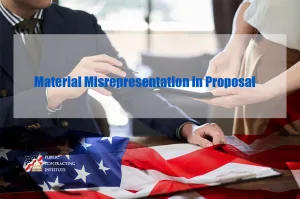A recent Government Accountability Office (“GAO”) bid protest demonstrates how easy it is for an offeror to make a material misrepresentation in its proposal, resulting in a sustained protest and the loss of an award. Sev1Tech, Inc., B-416811, Dec. 18, 2018. Two offerors, Sev1Tech and STI-TEC remained in the competitive range for a Coast Guard task order for project management, technical support and logistics services for the Aviation Business Operations Division. The Coast Guard awarded the contract to STI-TEC. In making the award, the Coast Guard had assigned a strength to SCI-TEC’s proposal on the basis of resumes submitted.

Sev1Tech protested that the STI-TEC proposal contained a material misrepresentation because STI-TEC proposed personnel the offeror did not have a reasonable expectation would be available for the task order. The Coast Guard stated that the solicitation did not require offerors to provide commitment letters or signed contingent letters of employment. STI-TEC provided names and resumes for 26 individuals in its proposal and specifically stated that it “has reached out to and negotiated contingent offers of employment with candidates for each position.” In its final revised proposal, STI-TEC stated that it had “identified and begun negotiating contingent offers of employment with the incumbent staff.” However, STI-TEC admitted that it had received the resumes for the 10 incumbent staff it proposed from its proposed subcontractor, which maintained a database that included the resumes of staff who performed under a previous task order. Additionally, STI-TEC admitted that it did not contact incumbent staff until it had been notified of the contract award.
Contrary to the representation in its proposal, STI-TEC had not reached out to and negotiated contingent offers of employment for each position, and did not have prior permission to submit the incumbent employees’ resumes or an expression of willingness by the individuals to consider employment with STI-TEC. STI-TEC asserted that its statement in the proposal that it had negotiated contingent offers of employment for each position was an “error caused by copying and pasting language from a previous proposal.” Further STI-TEC stated it did not intend to misrepresent its position with regards to the incumbent staff.
GAO completely rejected STI-TEC’s excuses. “[GAO has] stated before, that an offeror has an obligation to ensure the accuracy of its proposal representations.” GAO found the representation to be material because the Coast Guard relied on the resumes of incumbent staff that STI-TEC submitted, and the misrepresentation likely had a significant impact on the evaluation.
The Takeaway: Take the GAO warning to heart—every offeror has an obligation to ensure the accuracy of its proposal representations. This is particularly true when making representations about the actual availability of personnel. “Copy and paste errors” must be corrected before you submit a proposal. And you must ensure that if you state you have negotiated contingent offers of employment, that that fact is true. Alternatively, if you state that you have prior consent from incumbent staff to include them in your proposal, be sure you have a letter or an email from every incumbent staff member granting that consent.
For other helpful suggestions on government contracting, visit:
Richard D. Lieberman’s FAR Consulting at https://www.richarddlieberman.com/, and Mistakes in Government Contracting at https://richarddlieberman.wixsite.com/mistakes/.
